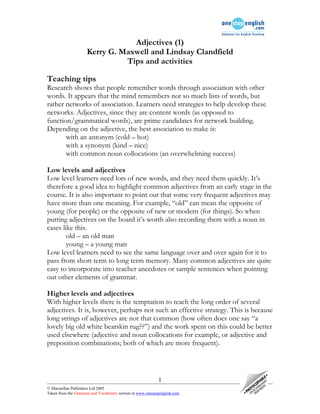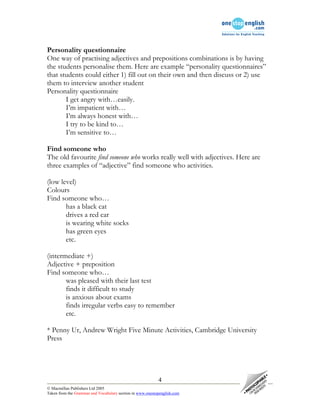Adjectives
- 1. Adjectives (1) Kerry G. Maxwell and Lindsay Clandfield Tips and activities Teaching tips Research shows that people remember words through association with other words. It appears that the mind remembers not so much lists of words, but rather networks of association. Learners need strategies to help develop these networks. Adjectives, since they are content words (as opposed to function/grammatical words), are prime candidates for network building. Depending on the adjective, the best association to make is: with an antonym (cold â hot) with a synonym (kind â nice) with common noun collocations (an overwhelming success) Low levels and adjectives Low level learners need lots of new words, and they need them quickly. Itâs therefore a good idea to highlight common adjectives from an early stage in the course. It is also important to point out that some very frequent adjectives may have more than one meaning. For example, âoldâ can mean the opposite of young (for people) or the opposite of new or modern (for things). So when putting adjectives on the board itâs worth also recording them with a noun in cases like this. old â an old man young â a young man Low level learners need to see the same language over and over again for it to pass from short term to long term memory. Many common adjectives are quite easy to incorporate into teacher anecdotes or sample sentences when pointing out other elements of grammar. Higher levels and adjectives With higher levels there is the temptation to teach the long order of several adjectives. It is, however, perhaps not such an effective strategy. This is because long strings of adjectives are not that common (how often does one say âa lovely big old white bearskin rug??â) and the work spent on this could be better used elsewhere (adjective and noun collocations for example, or adjective and preposition combinations; both of which are more frequent). 1 ÂĐ Macmillan Publishers Ltd 2005 Taken from the Grammar and Vocabulary section in www.onestopenglish.com
- 2. Attributive and predicative adjectives In teaching the grammar of adjectives, most course materials focus on: placement of adjectives and comparative/superlative forms. Attributive and predicative adjectives are explicitly addressed so seldom that many English teachers might not even know what they are. It is worthwhile pointing out this aspect of adjectives to students though, especially if they come across an adjective in a text that can only be used in one position or another (see activity on Using Texts below). Activities Adjective alphabet With low to pre-intermediate learners you can challenge them to alter a simple sentence by adding a different adjective each time: one adjective for each letter of the alphabet. For example: Write the sentence âHeâs just a/an _______ baby.â on the board Then say: âHeâs just an amazing baby.â Ask another student to continue with an adjective beginning with the letter b. S1 Heâs just a beautiful baby. S2 Heâs just a common baby. and so onâĶ Think ofâĶ You can ask learners to provide examples themselves of people or things which have the quality of the adjectives you have taught. Imagine youâve taught adjectives to describe a personâs appearance (to a low level group for example). Ask the students to come up with examples of: a handsome movie actor a beautiful singer a tall politician an ugly old man a short actress a middle-aged TV actor A variation of this activity would be to have students do the activity in small groups. Have each group read out their answers in front of the class. For every example that a group has which no other group has written, the group scores a point. The group with the most points at the end wins. 2 ÂĐ Macmillan Publishers Ltd 2005 Taken from the Grammar and Vocabulary section in www.onestopenglish.com
- 3. Three adjectives â what do they describe? Penny Ur suggests a great activity* with adjectives, where the teacher gives the students three adjectives and the students must come up with words that these three adjectives could describe. So, for the adjectives long, difficult and boring a group of students I had recently came up with the following nouns: a test, a lecture, school, Monday mornings, the Lord of the Rings films (I didnât agree with the last one!). A variation of this activity could be two adjectives joined with either AND or BUT. Example pairs of adjectives: long and difficult quick but complicated important but dangerous green and happy etc. Before or after? With advanced classes, you can draw attention to adjectives that can go in more than one position and discuss the difference in meaning. Here are two examples: concerned The police called a meeting to listen to the (1) ________ parents (2) ________ What is the difference between placing concerned in position 1 or position 2? responsible We only want to talk with (1) ___________ people (2) _____________. What is the difference between placing responsible in position 1 or position 2? Using texts After working on a text for comprehension, you could instruct advanced learners to find all the adjectives and discuss their position. Which ones are attributive and which are predicative? Is it possible to change certain sentences so that the adjectives are in a different position? What effect does this have on the text? Jazz up a text Another option is to take a relatively simple text and ask students to add more adjectives to it to âjazz it upâ. The key here would be to choose a short text. Try taking a short text from an elementary coursebook to use with intermediate students. 3 ÂĐ Macmillan Publishers Ltd 2005 Taken from the Grammar and Vocabulary section in www.onestopenglish.com
- 4. Personality questionnaire One way of practising adjectives and prepositions combinations is by having the students personalise them. Here are example âpersonality questionnairesâ that students could either 1) fill out on their own and then discuss or 2) use them to interview another student Personality questionnaire I get angry withâĶeasily. Iâm impatient withâĶ Iâm always honest withâĶ I try to be kind toâĶ Iâm sensitive toâĶ Find someone who The old favourite find someone who works really well with adjectives. Here are three examples of âadjectiveâ find someone who activities. (low level) Colours Find someone whoâĶ has a black cat drives a red car is wearing white socks has green eyes etc. (intermediate +) Adjective + preposition Find someone whoâĶ was pleased with their last test finds it difficult to study is anxious about exams finds irregular verbs easy to remember etc. * Penny Ur, Andrew Wright Five Minute Activities, Cambridge University Press 4 ÂĐ Macmillan Publishers Ltd 2005 Taken from the Grammar and Vocabulary section in www.onestopenglish.com



